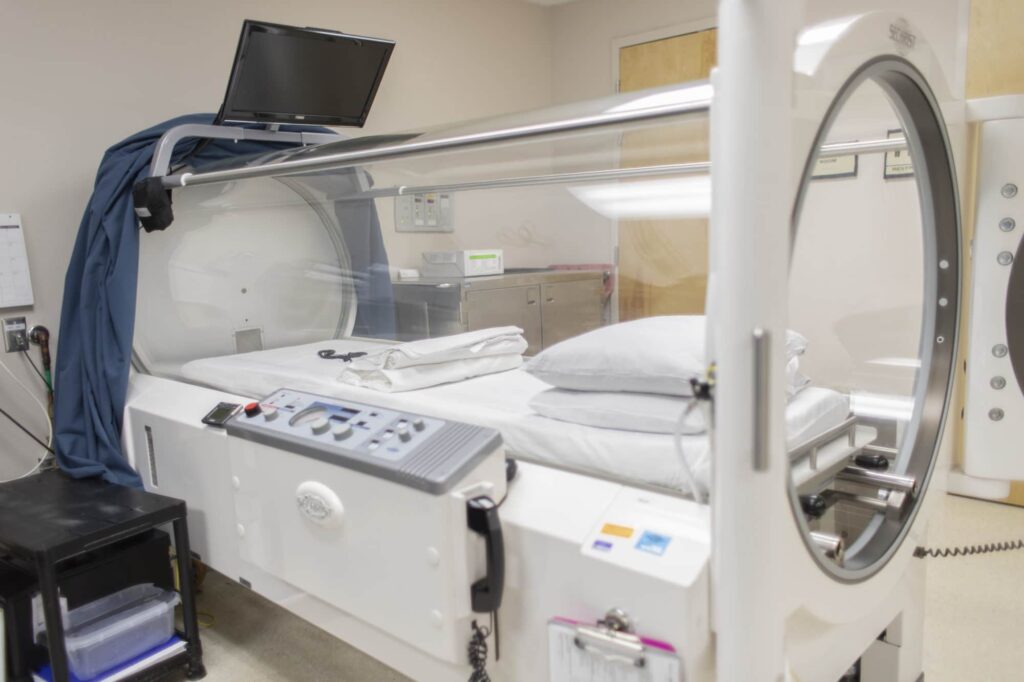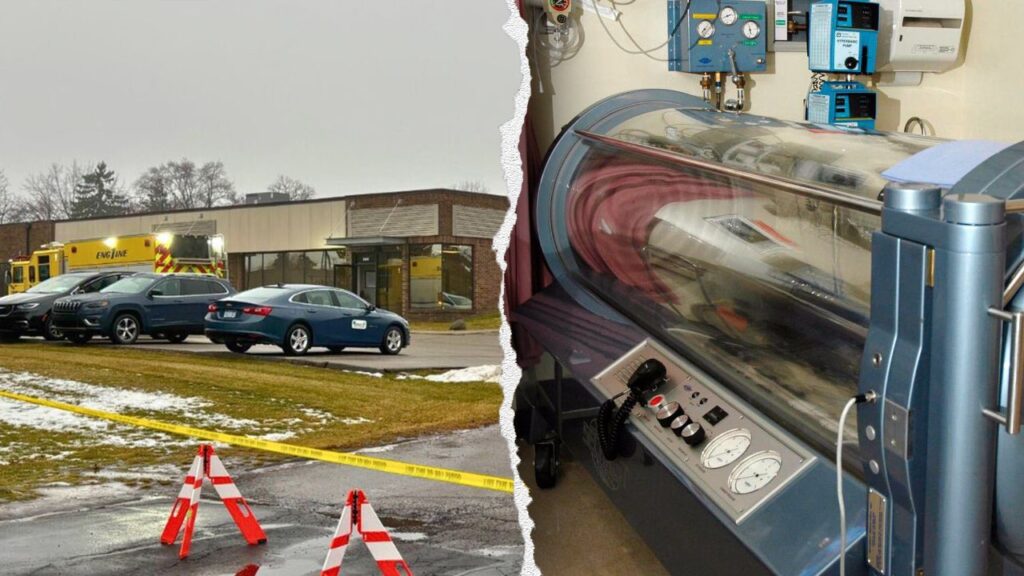
On January 31, 2025, the community in Troy, Michigan, was shaken by a heartbreaking incident at the Oxford Center—a facility offering hyperbaric oxygen therapy. The fire that broke out in the hyperbaric chamber not only resulted in the tragic loss of 5-year-old Thomas Cooper but also left his mother with severe injuries. In a case that has raised serious concerns about safety and oversight in alternative medical treatments, four individuals have now been charged, highlighting the critical issues surrounding the regulation and management of hyperbaric chambers.
Incident Overview: A Devastating Day in Troy
In the early hours of January 31, 2025, emergency services responded to a fire at the Oxford Center in Troy, Michigan. The facility, which specialized in hyperbaric oxygen therapy (HBOT), had a chamber filled with 100% oxygen—an environment known to be highly combustible. Unfortunately, during one of the sessions, a fire ignited within the hyperbaric chamber, leading to an explosion that proved fatal for young Thomas Cooper.
This tragic incident was not only a loss for the family but also a stark reminder of the inherent risks associated with operating in an oxygen-rich environment. The chamber’s high oxygen content, while beneficial for certain therapeutic purposes, can escalate any minor spark into a dangerous blaze.
What is a Hyperbaric Chamber?

Before delving deeper into the case, it is essential to understand what a hyperbaric chamber is and its role in medical therapy. A hyperbaric chamber is a pressurized container in which patients receive oxygen at levels higher than atmospheric pressure. This process, known as hyperbaric oxygen therapy, is used to treat various conditions such as decompression sickness, carbon monoxide poisoning, and wound healing issues.
The unique environment inside a hyperbaric chamber can enhance the body’s natural healing process, but it also requires strict safety protocols. With 100% oxygen filling the chamber, even the smallest ignition source can result in catastrophic outcomes. This delicate balance between therapeutic benefit and potential hazard is at the heart of the ongoing investigation at the Oxford Center.
The Oxford Center and Its Controversial Practices
The Oxford Center, founded in 2008 by Tamela Peterson, has been a prominent provider of alternative therapies, including HBOT. However, the center’s practices have long been under scrutiny. Despite promoting HBOT for a wide range of conditions—some not officially recognized by the FDA—the facility was never accredited by the Undersea and Hyperbaric Medical Society. This lack of accreditation, combined with a history of employing individuals with controversial backgrounds, has raised red flags about the center’s commitment to safety.
Regulatory Gaps and Safety Oversight
Michigan law currently does not mandate licensing or strict oversight for facilities offering hyperbaric oxygen therapy. This regulatory gap has allowed the Oxford Center to operate without the rigorous checks that accredited facilities undergo. Experts warn that such gaps can lead to significant safety risks, as seen in the tragic incident involving the hyperbaric chamber fire.
The investigation into the fire has brought these concerns into sharp focus. Questions about the proper management of oxygen-rich environments and the necessity for accredited, well-regulated facilities are now at the forefront of the debate. Many in the medical community and regulatory bodies are calling for stricter oversight to prevent future tragedies.
Charges and Legal Proceedings
In a dramatic turn of events, four individuals associated with the Oxford Center have been charged in connection with the fatal incident:
- Tamela Peterson – The founder and CEO, has been charged with second-degree murder. Her role in establishing and managing the center is under intense scrutiny, especially considering the facility’s past controversies.
- Gary Marken – A director at the center, also faces second-degree murder charges, reflecting the gravity of the management’s role in the incident.
- Jeffrey Mosteller – Another director, charged similarly, is believed to have shared responsibility for the operational decisions that may have compromised safety.
- Aleta Moffitt – Charged with involuntary manslaughter and falsifying medical records, her involvement hints at potential administrative negligence that might have exacerbated the situation.
Second-degree murder is a big deal—it suggests prosecutors believe these folks acted with reckless disregard for safety, leading to Thomas’s death. Moffitt’s lesser charge might mean she wasn’t as directly involved in the operational failures, but her actions still contributed. The investigation is ongoing, so expect more details as this heads to court.
Investigating the Fire: What Went Wrong?
The precise cause of the fire is still under investigation, but preliminary evidence points toward several key issues:
The Role of High Oxygen Concentration
Hyperbaric chambers operate by creating an environment rich in oxygen. While this is crucial for the therapeutic benefits of HBOT, it also means that even minimal ignition can lead to a rapid and uncontrollable fire. In this case, the chamber’s 100% oxygen content provided a perfect storm for a catastrophic failure.
Possible Negligence and Lack of Proper Regulation
Investigators suspect that negligence and poor management practices played a significant role. The Oxford Center’s failure to comply with established safety standards—partly due to its non-accredited status—has been a critical point of focus. The fact that the facility promoted treatments for conditions like ADHD, which are not widely endorsed by major health authorities, further deepens the concerns regarding its operational integrity.
Historical Precedents and Expert Opinions
Historical data shows that hyperbaric chambers, while generally safe when managed correctly, have been involved in previous incidents. For instance, a study noted 77 fatalities from 35 chamber fires over several decades, largely attributed to improper handling of the high-oxygen environment. Experts, including fire safety officials, stress that strict adherence to safety protocols and regular inspections are non-negotiable when dealing with such volatile equipment.
The Human Cost and Community Impact
The loss of young Thomas Cooper has sent shockwaves through the community, igniting public outcry over the safety standards at the Oxford Center. His mother, who sustained injuries during the incident, now faces a long road to recovery both physically and emotionally. The tragedy has also spurred local advocacy groups and concerned citizens to demand tighter regulations on facilities that administer hyperbaric oxygen therapy.

Family’s Response and Legal Action
In the wake of the tragedy, Thomas Cooper’s family has taken decisive legal action by retaining a prominent law firm. Their attorney has emphasized that this is not just a case of isolated negligence but a systemic failure of regulatory oversight. The family’s decision to pursue legal action underscores a broader call for reform within the industry, ensuring that no other family has to endure such heartbreak.
Community and Expert Reactions
Local officials, emergency responders, and medical experts have all voiced their concerns about the incident. Fire Lt. Keith Young remarked on the rarity of such an occurrence in his decade-long career, while experts in oxygen therapy emphasize the urgent need for improved safety measures. The community’s reaction has been one of grief, shock, and a fervent demand for accountability—a sentiment that is resonating far beyond Michigan’s borders.
Implications for Hyperbaric Chamber Safety
The incident at the Oxford Center serves as a critical lesson in the importance of safety and regulation when it comes to operating a hyperbaric chamber. Here are some key takeaways:
Need for Accreditation and Licensing
Facilities offering hyperbaric oxygen therapy should be required to obtain accreditation from recognized bodies such as the Undersea and Hyperbaric Medical Society. Accreditation ensures that the facility meets strict safety standards and is regularly inspected for compliance.
Stricter Regulatory Oversight
Michigan’s current regulatory framework for hyperbaric chambers is inadequate. There is a growing consensus among experts that state lawmakers must enforce stricter licensing requirements and safety protocols to protect patients and prevent future tragedies.
Enhanced Training and Emergency Preparedness
Operators and staff at facilities utilizing hyperbaric chambers should undergo rigorous training in both routine operations and emergency response. This includes regular drills, fire safety training, and clear protocols for dealing with potential oxygen leaks or ignition sources.
Technological Advancements and Safety Innovations
Advancements in technology could help mitigate some of the risks associated with hyperbaric chambers. Innovations such as improved fire suppression systems and more sophisticated monitoring equipment could significantly reduce the likelihood of a similar incident occurring in the future.
Broader Context: The Alternative Medicine Debate
The Oxford Center’s controversy is not just about a tragic fire—it also touches on a broader debate surrounding alternative medical treatments. Hyperbaric oxygen therapy has been touted for its potential to treat a range of conditions, from chronic wounds to neurological disorders. However, the lack of consensus among medical professionals about its efficacy for certain conditions, such as ADHD or autism, has sparked considerable debate.
The Promise and Perils of HBOT
Proponents of HBOT argue that it offers a non-invasive treatment option that can significantly improve patient outcomes. On the other hand, critics warn that without proper regulation and oversight, the risks may outweigh the benefits. The incident in Troy is a stark example of what can go wrong when safety protocols are not rigorously enforced.
Expert Opinions and Case Studies
Several case studies have shown that when managed correctly, hyperbaric oxygen therapy can be life-saving. However, experts agree that every facility must adhere to the highest safety standards to prevent accidents. In this context, the tragic death of Thomas Cooper serves as a cautionary tale, urging both regulators and practitioners to re-evaluate current practices and prioritize patient safety above all else.
Moving Forward: Lessons Learned and the Road to Reform

The charges brought against the Oxford Center’s management underscore the urgent need for systemic change in the oversight of hyperbaric chamber facilities. As investigations continue, the incident is likely to serve as a catalyst for new legislation and tighter safety standards not only in Michigan but across the United States.
Policy Reforms on the Horizon
Lawmakers and regulatory bodies are now under pressure to re-examine existing regulations. There is growing support for mandatory accreditation of all facilities offering hyperbaric oxygen therapy, coupled with regular safety audits and strict licensing requirements. Such reforms could help prevent future tragedies and restore public confidence in alternative medical treatments.
Community Advocacy and Industry Responsibility
Community groups, patient advocates, and even some industry insiders are calling for accountability and greater transparency in the operation of hyperbaric chambers. The hope is that, through collective action and stringent regulatory reforms, similar incidents will become a thing of the past.
Conclusion: A Call for Accountability and Change
The fatal hyperbaric chamber fire at the Oxford Center is a deeply tragic event that has left a lasting impact on the community and raised serious questions about the safety of alternative medical therapies. With four individuals now facing serious charges, the case highlights the dangerous consequences of regulatory gaps and negligent management practices.
As the investigation unfolds, it is imperative that authorities, medical professionals, and lawmakers work together to implement robust safety protocols and ensure that every hyperbaric chamber is operated with the utmost care. Only through accountability and decisive action can we hope to prevent such tragedies in the future and safeguard the lives of those who rely on these potentially life-saving therapies.
Frequently Asked Questions (FAQs)
1. What is a hyperbaric chamber?
A hyperbaric chamber is a pressurized environment where patients breathe pure oxygen at levels higher than the atmospheric pressure. It is used in hyperbaric oxygen therapy (HBOT) to enhance the body’s natural healing processes.
2. How did the fire at the Oxford Center start?
The investigation is still ongoing, but early indications suggest that the fire may have been triggered by the chamber’s high oxygen environment, which can cause even a small spark to lead to a large, rapidly spreading fire.
3. Who has been charged in connection with the incident?
Four individuals associated with the Oxford Center have been charged: Tamela Peterson, Gary Marken, Jeffrey Mosteller (all charged with second-degree murder), and Aleta Moffitt (charged with involuntary manslaughter and falsifying medical records).
4. Why are hyperbaric chambers considered high-risk?
Hyperbaric chambers contain 100% oxygen, which can dramatically increase the risk of fire if any ignition source is present. This makes it crucial to follow stringent safety protocols and maintain proper oversight.
5. Are there any regulations for hyperbaric oxygen therapy facilities in Michigan?
Currently, Michigan law does not require strict licensing or accreditation for hyperbaric oxygen therapy facilities, a gap that has raised significant safety concerns and is now under review following this tragic incident.
6. What measures can be taken to prevent such incidents in the future?
Improvements include enforcing accreditation from recognized bodies, implementing strict safety protocols, providing enhanced training for staff, and adopting advanced fire suppression systems in hyperbaric chambers.
7. How is the community responding to this tragedy?
Local residents, advocacy groups, and legal experts are calling for tighter regulations and greater accountability within the industry. The loss of young Thomas Cooper has spurred widespread demands for reform to ensure that all facilities adhere to the highest safety standards.
This heartbreaking incident underscores the vital need for regulatory reform and rigorous safety measures in the operation of hyperbaric chambers. By addressing these critical issues, we can help protect patients, restore public trust, and prevent similar tragedies from occurring in the future.

1 thought on “Tragic Blaze: 4 Charged in Fatal Hyperbaric Chamber Fire in Michigan!”